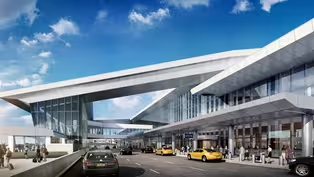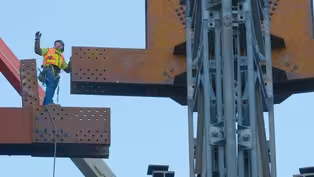
What Happens to Your Checked Bag at the Airport?
Clip: Season 52 Episode 2 | 2m 34sVideo has Closed Captions
Getting the right bag to the right plane requires an ingenious system. Here’s how it works.
Have you ever wondered what happens to your checked bag at an airport? At LaGuardia Airport, their new, state-of-the-art tracking system was designed to process 40 million bags a year— up to 6,000 bags every hour. Discover how this ingenious system works.
Problems playing video? | Closed Captioning Feedback
Problems playing video? | Closed Captioning Feedback
National Corporate funding for NOVA is provided by Carlisle Companies and Viking Cruises. Major funding for NOVA is provided by the NOVA Science Trust, the Corporation for Public Broadcasting, and PBS viewers.

What Happens to Your Checked Bag at the Airport?
Clip: Season 52 Episode 2 | 2m 34sVideo has Closed Captions
Have you ever wondered what happens to your checked bag at an airport? At LaGuardia Airport, their new, state-of-the-art tracking system was designed to process 40 million bags a year— up to 6,000 bags every hour. Discover how this ingenious system works.
Problems playing video? | Closed Captioning Feedback
How to Watch NOVA
NOVA is available to stream on pbs.org and the free PBS App, available on iPhone, Apple TV, Android TV, Android smartphones, Amazon Fire TV, Amazon Fire Tablet, Roku, Samsung Smart TV, and Vizio.
Buy Now

NOVA Labs
NOVA Labs is a free digital platform that engages teens and lifelong learners in games and interactives that foster authentic scientific exploration. Participants take part in real-world investigations by visualizing, analyzing, and playing with the same data that scientists use.Providing Support for PBS.org
Learn Moreabout PBS online sponsorship- [Narrator] In New York City, (dramatic music) designers, engineers, and construction workers... - Watch the boom.
- are on a once in a lifetime mission to build an extraordinary airport.
The city's new LaGuardia Airport has a budget of more than $8 billion and will be America's first new airport in more than 25 years.
Inside, the team is completing the installation of the airport's vast new baggage system.
The new airport must be able to process 40 million bags each year.
Getting the right bag to the right aircraft requires an ingenious system.
- Each bag is given a bag tag.
This bag tag becomes basically the license plate of the bag.
This bag tag has a unique identifier that will then be tracked throughout the entire system.
- [Narrator] A network of scanners reads the tags and automatically directs the bags left or right to the correct loading bay.
Vertical sorting units also move bags up or down a level, if needed.
Before all baggage moves airside, the conveyors shuttle it through security.
- The new state-of-the-art technology that we have in security can pick up anything, but if it picks it up, it's dealing with it, dealing with it swiftly.
- [Narrator] With up to 6,000 bags to check every hour, how can engineers ensure a suspicious bag is not sent on to the aircraft?
Special explosive detection machines scan every bag.
If they raise a red flag, bags are rerouted to TSA agents on the lower floor for hand checking, while cleared bags must go up a level to reach the gates.
Vertical sorting units, VSUs, are an essential part of the security system.
Their conveyors divert the bags either up or down, depending on whether they are cleared or not.
The VSUs automatically ensure a suspicious bag never makes it onto an aircraft, keeping the skies safe for passengers.
- It's protection of life, protection of property, then resume operations.
The $8 Billion Overhaul of LaGuardia Airport: Engineering a New Era
Video has Closed Captions
Clip: S52 Ep2 | 2m 12s | Discover how an $8 billion transformation turned LaGuardia into a state-of-the-art facility. (2m 12s)
Extreme Airport Engineering Preview
Video has Closed Captions
Preview: S52 Ep2 | 30s | Follow the race to build a world-class airport on the site of one of America’s busiest flying hubs. (30s)
Providing Support for PBS.org
Learn Moreabout PBS online sponsorship
- Science and Nature

Capturing the splendor of the natural world, from the African plains to the Antarctic ice.













Support for PBS provided by:
National Corporate funding for NOVA is provided by Carlisle Companies and Viking Cruises. Major funding for NOVA is provided by the NOVA Science Trust, the Corporation for Public Broadcasting, and PBS viewers.




